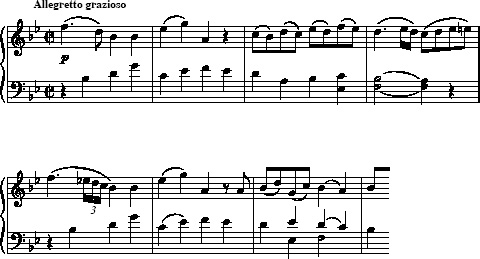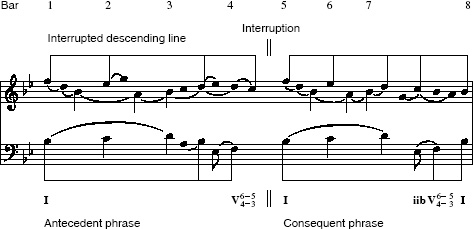5.2 Identifying an interrupted structure
We are going to begin our case studies by considering the whole eight-bar opening theme of the third movement of Mozart's Sonata in B flat, K333.
Activity 14
Listen to Extract 9, following the score given as Example 23. In the most general terms, how would you describe the phrase structure of this theme?
Click to listen to Extract 9

Discussion
This eight-bar phrase is typical of Mozart's style. It sounds self-contained by virtue of its final cadence in the tonic. It also falls neatly into two halves: an antecedent phrase ending on the dominant (bars 1–4), and a consequent phrase ending on the tonic (bars 5–8).This sort of regular ‘question-and-answer’ phrasing is very characteristic of Viennese Classicism, although you will also have come across it in many other tunes (Greensleeves, for example).
Let's look more closely at this theme. The melodic content of the two halves is actually very similar. There is one obvious difference: whereas the first half outlines a large linear motion to the second degree of the scale (C), the second half moves downwards all the way to the tonic (B♭).
Now look at my analysis of this theme, summarised as a graph in Example 24.

Activity 15
Compare the graph in Example 24 with the score extract in Example 23. How does the graph analyse the phrase structure I have just described?
Discussion
The graph shows the whole theme as governed by a large line moving downwards through a fifth to the tonic (like my previous example from K309). However, in this case the line does not move straight to its closure, but is instead broken off at the halfway point. It is then repeated in the second half, this time reaching its goal, the tonic, at the end. In the bass, the binary nature of the phrase is emphasised by the dominant chord at the halfway point.
This theme is an example of an interruption of the main structural line, one of the commonest and most important forms of middleground prolongation in Classical music. Instead of going straight to a perfect cadence in the tonic, the music comes to rest on a dominant chord (an imperfect cadence) at the halfway point (this is called a dividing dominant because it cuts the structure into two halves). Not only is the bass line interrupted by chord V, but the top line is interrupted as well. You can see that the treble descends as far as the second degree (the supertonic, C), supported by the dominant, in the first half of the theme. It then returns to the primary tone (F) at the start of the second, and finally descends to form a perfect cadence in the tonic.
I will not go into great detail concerning this graph because we have already spent some time with the first half of the theme in AA314_1, but it is worth mentioning the treatment of the cadential 6/4 chords in this example (bars 4 and 7). In both cases, the 6/4 chord is analysed as a dissonance, for the reasons we discussed just now in relation to the extract from K309. At the end of the first half here, the true structural note over the dividing dominant is C rather than D (the D is analysed, as before, as a sort of suspension). Likewise, at the final cadence, the true structural degree is the tonic B♭ supported by Ia in bar 8, not the B♭ on the last beat of bar 7, which is supported by a 6/4 chord. This again is a suspension, and serves to prolong the dominant harmony. The acid test for such decisions is to stop the music on the 6/4 chord; if it does not sound complete, it cannot be the true termination of the structural line.
